This document provides an analysis of 5 science fiction novels that explored ethical issues arising from advances in biotechnology:
1. Frankenstein warns of the dangers of pursuing scientific advancement without consideration for consequences.
2. The Island of Dr. Moreau criticizes research done solely for curiosity's sake without benefit to society.
3. The Strange Case of Dr. Jekyll and Mr. Hyde examines the idea of separating good and evil within a person.
4. The Invisible Man and 5. The Food of the Gods also portray scientists disregarding ethics in their experiments.
The document argues that these early science fiction works highlighted real risks that the biotechnology industry still faces today and stresses the need for corporations to



![4
What is Corporate Citizenship?
The term corporate citizenship is difficult to define for "there is no single indicator of good
[corporate] citizenship. It must be measured through lenses representing various viewpoints."ii
In
the biotech industry there are definitions (often conflicting) from corporations, academic
researchers, animal right activists, environmentalists, and others. While I cannot claim to have
the answer, I can offer an interpretation for this discourse. The biotech industry - including
medical, biological, and pharmaceutical organizations - faces a unique set of ethical issues.
Every product they bring forth and every piece of data they research will impact this world. As
medical research moves beyond the academic and further into the for-profit business world, good
corporate citizenship must become as important to management as is the bottom line. Here a
good corporate citizen (1) attempts to minimize any negative consequences and (2) takes
responsibility for its actions, including any unforeseen problems.
Bioethics developed in response to the rapid scientific advances of the late 18th
and early 19th
centuries. This new era of biotechnology and medical miracles unfortunately also opened a
Pandora's Box of ethical issues. One of the earliest authors of bioethics is Claude Bernard, a
renowned French physiologist. His 1865 Introduction to the Study of Experimental Medicine is
often quoted as the cornerstone of bioethics. His principle expands on the Hippocratic Oath to
"do no harm,"
It is our duty and right to perform an experiment on man whenever it can save his
life, cure him or gain him some personal benefit. The principle of medical and
surgical morality, therefore, consists in never performing on a man an
experiment, which might be harmful to him in any extent, even though the result
might be highly advantageous to science, that is, to the health of others.iii](https://image.slidesharecdn.com/66392d2b-228c-4388-96e1-55160315faf7-150811063238-lva1-app6892/85/Lessons_of_the_past-4-320.jpg)
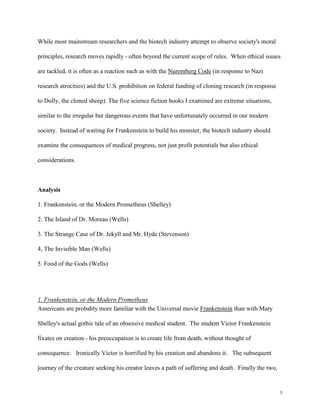
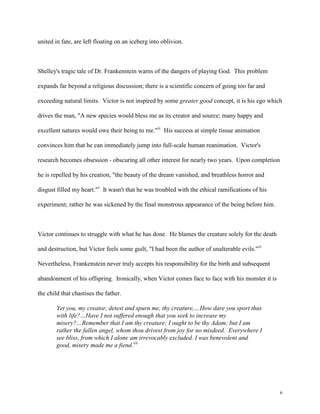
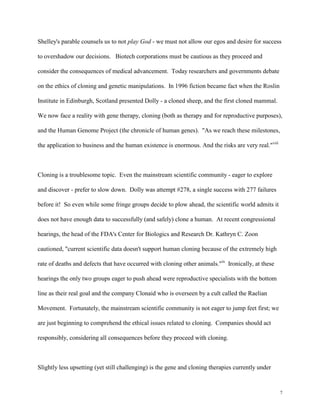

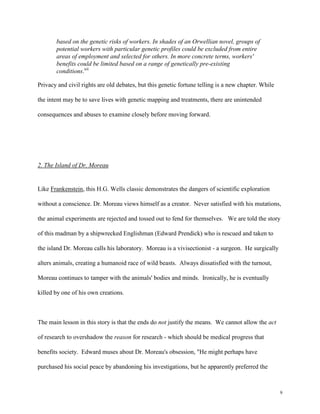

![11
Doctors' Trial was held, accusing 23 medical doctors and administrators of
…murder, tortures and other atrocities committed in the name of medical
science…subjecting unwilling victims to medical procedures that were loosely called
'scientific experiments,' thereby having caused their death, disfigurement, or
disability…Never before or since has medicine's major moral mandate, 'do no harm,'
been so flagrantly, unambiguously, and indefensibly violated than by the Nazi crime.xviii
Consequently, the Nuremberg Code (primarily penned by American Dr. Andrew C. Ivy) was
adopted as international law on 19 July 1947. The 10 points of the code include ethical
considerations such as "The voluntary consent of the human subject is absolutely essential.
[…and…] The experiment should be such as to yield fruitful results for the good of society.
[…and…] The experiment should be conducted as to avoid all unnecessary physical and mental
suffering and injury."xix
Ironically, many non-German doctors believed "It was a good code for barbarians but an
unnecessary code for ordinary physicians."xx
No ethical scientist would accept the experiments
as legitimate research: depriving people of oxygen until they died, freezing victims to death,
infecting people with malaria and other diseases then administering experimental treatments
(many died from the infections and many more from the therapies), testing various sterilization
techniques, and poisoning people for observation. However, fringe elements exist, often
clandestine. Fortunately, as research intensified after the war, international and national
organizations were motivated to ensure it did not happen again. The World Medical Association
ratified Principles for Those in Research and Experimentation in 1954. Then in 1964 the
Helsinki Declarations further demonstrated that "research in which the aim is primarily
diagnostic or therapeutic for a particular patient (called clinical research) is distinguished from
research that is purely scientific, without expected benefit for the patient (nonclinical](https://image.slidesharecdn.com/66392d2b-228c-4388-96e1-55160315faf7-150811063238-lva1-app6892/85/Lessons_of_the_past-11-320.jpg)


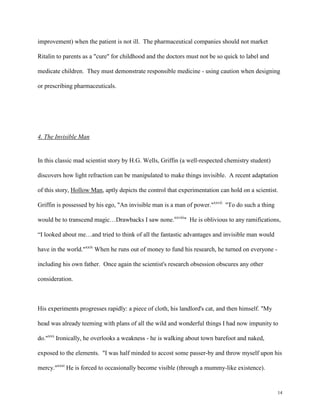
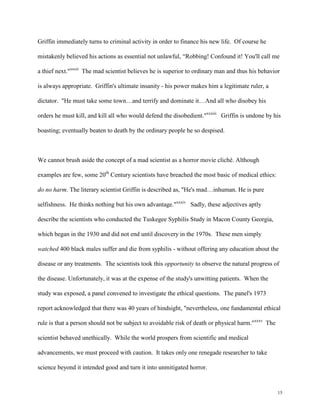


![18
continue.
The pharmaceutical companies seem to be continuously releasing a new miracle drug. Rarely do
these drugs perform miracles, and sometimes with unforeseen (or ignored) consequences. Only a
few decades ago that an amazing new drug Thalidomide was introduced as a sleeping pill.
Believed to also relieve morning sickness, Thalidomide was prescribed to thousands of pregnant
women, resulting in severe birth defects including limb deformity. On 15 July 1962, the
Washington Post broke the story of numerous European children born missing one or more
limbs. At that time Merrell Pharmaceuticals in America was putting intense pressure on the FDA
to approve Thalidomide (brand name Kevedon). Despite its lack of FDA acceptance
Thalidomide was available on the market as an experimental drug. By the time it was stopped,
doctors had given samples of the drug to over 20,000 women in America. In 1960 Dr. Kelsey of
the FDA had noted that "Merrell had compiled an interesting collection of meaningless
pseudoscientific jargon apparently intended to impress chemically unsophisticated readers."xxxix
Later the British Medical Journal cautioned about user side effects, and then possible fetal
effects began to emerge. Merrell finally withdrew its FDA application in March 1962, shortly
before the story broke in the Washington Post. Shortly thereafter the "Kefauver-Harris
amendments [to the Senate's Federal Food, Drug and Cosmetic Act] strengthened the
government's control over the approval of new drugs, demanding 'substantial evidence of
efficacy' and requiring for the first time full and free consent of all subjects of drug trials
conducted within the United States."xl
The tragedy of Thalidomide is "a story of moral
courage…commercial greed and political collusion."xli
Merrell's biggest mistake was putting
profit before benefit.](https://image.slidesharecdn.com/66392d2b-228c-4388-96e1-55160315faf7-150811063238-lva1-app6892/85/Lessons_of_the_past-18-320.jpg)


![21
Bibliography
Baker, Mark W. And Degruyther, Nigel: October 2000, "Protecting Ideas", Risk Management Magazine,
pages 35-43.
Blank, Robert H. and Bonnicksen, Andrea L. [editors]: 1992, Emerging Issues in Biomedical Policy,
(Columbia University Press, New York).
Brocket, Patrick L. and Takersleym E. Susan: November 1997, "The Genetics revolution, Economics,
Ethics, and Insurance", Journal of Business Ethics, pages 1661-1676.
Harris, Gardiner (April 23, 2001): "AIDS Gaffes in Africa Come Back To Haunt Drug Industry in the
U.S.", the Wall Street Journal.
Jonsen, Albert R.: 1998, the Birth of Bioethics, (Oxford University Press, New York).
Jonsen, Albert R. et al [editors]: 1998, Source Book in Bioethics, (Georgetown University Press,
Washington D.C.).
Levine, Carol [editor]: 1999, Taking Side - Clashing Views on Controversial Bioethical Issues 8th
Edition, (Duskin/McGraw-Hill, Connecticut).
Middleton, Otesa (March 28, 2001): "FDA Official Says Cloning Too Unsafe To Approve", The Wall
Street Journal.
Newton, Lisa H. and Ford, Maureen M. [editors]: 1998, Taking Side - Clashing Views on Controversial
Business Ethics and Society 5th
Edition, (Duskin/McGraw-Hill, Connecticut).
Shelley, Mary: 1818 [1973 reprint), Frankenstein or the Modern Prometheus, (Dutton, New York).
Stevenson, Robert Louis: 1886 [1981 reprint], Dr. Jekyll and Mr. Hyde, (Bantam Books, New York)
Wells, Herbert George: 1978 edition, The Complete Science Fiction Treasury of H. G. Wells, (Avenel
Books, New York).
The Invisible Man
The Island of Dr. Moreau
The Food of the Goods
Wilmont, Stephen: 2001, Corporate Moral Responsibility: "What Can We infer from Our Understanding
of Organizations", Journal of Business Ethics, Volume 30, pages 161-169.
Dow Jones Newswires
March 27, 2001 Abbott Labs Confirms Cutting AIDS Drugs Prices in Africa
March 28, 2001 Congress, Pres Bush Move Toward Banning Human Cloning
April 4, 2001 South African Pres Advisory Council Releases AIDS Report
April 5, 2001 UN Chief Urges Pharm Co Execs To Cut AIDS-Drug Prices
CNN.com
September 1, 1999 ADHD may be overdiagnosed, study says
http://www.cnn.com/HEALTH/9909/01/adhd.overdiagnosis/index.html
May 2, 2000 Professional group seeks consistency in diagnosing attention deficiency in children
http://www.cnn.com/2000/HEALTH/05/02/adhd.diagnosis/index.html](https://image.slidesharecdn.com/66392d2b-228c-4388-96e1-55160315faf7-150811063238-lva1-app6892/85/Lessons_of_the_past-21-320.jpg)
